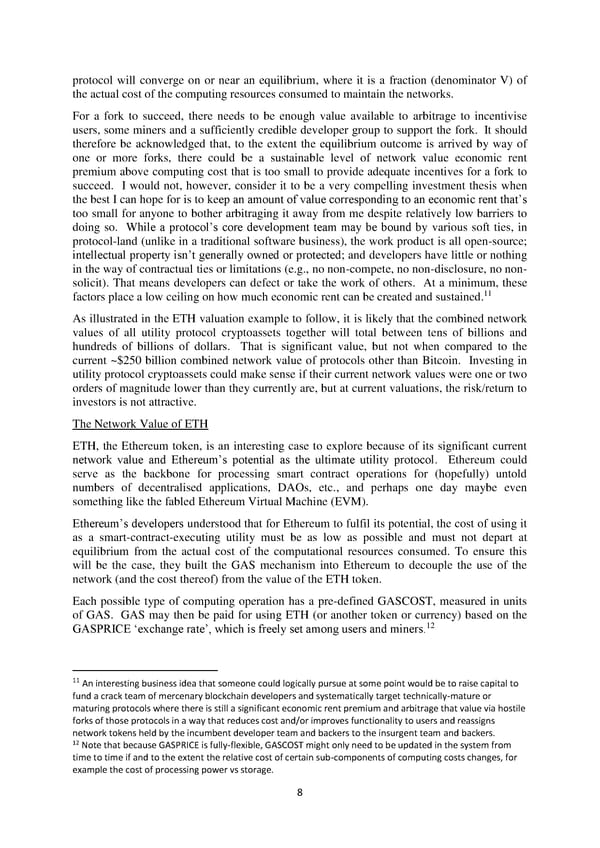protocol will converge on or near an equilibrium, where it is a fraction (denominator V) of the actual cost of the computing resources consumed to maintain the networks. For a fork to succeed, there needs to be enough value available to arbitrage to incentivise users, some miners and a sufficiently credible developer group to support the fork. It should therefore be acknowledged that, to the extent the equilibrium outcome is arrived by way of one or more forks, there could be a sustainable level of network value economic rent premium above computing cost that is too small to provide adequate incentives for a fork to succeed. I would not, however, consider it to be a very compelling investment thesis when the best I can hope for is to keep an amount of value corresponding to an economic rent that’s too small for anyone to bother arbitraging it away from me despite relatively low barriers to doing so. While a protocol’s core development team may be bound by various soft ties, in protocol-land (unlike in a traditional software business), the work product is all open-source; intellectual property isn’t generally owned or protected; and developers have little or nothing in the way of contractual ties or limitations (e.g., no non-compete, no non-disclosure, no non- solicit). That means developers can defect or take the work of others. At a minimum, these factors place a low ceiling on how much economic rent can be created and sustained.11 As illustrated in the ETH valuation example to follow, it is likely that the combined network values of all utility protocol cryptoassets together will total between tens of billions and hundreds of billions of dollars. That is significant value, but not when compared to the current ~$250 billion combined network value of protocols other than Bitcoin. Investing in utility protocol cryptoassets could make sense if their current network values were one or two orders of magnitude lower than they currently are, but at current valuations, the risk/return to investors is not attractive. The Network Value of ETH ETH, the Ethereum token, is an interesting case to explore because of its significant current network value and Ethereum’s potential as the ultimate utility protocol. Ethereum could serve as the backbone for processing smart contract operations for (hopefully) untold numbers of decentralised applications, DAOs, etc., and perhaps one day maybe even something like the fabled Ethereum Virtual Machine (EVM). Ethereum’s developers understood that for Ethereum to fulfil its potential, the cost of using it as a smart-contract-executing utility must be as low as possible and must not depart at equilibrium from the actual cost of the computational resources consumed. To ensure this will be the case, they built the GAS mechanism into Ethereum to decouple the use of the network (and the cost thereof) from the value of the ETH token. Each possible type of computing operation has a pre-defined GASCOST, measured in units of GAS. GAS may then be paid for using ETH (or another token or currency) based on the GASPRICE ‘exchange rate’, which is freely set among users and miners.12 11 An interesting business idea that someone could logically pursue at some point would be to raise capital to fund a crack team of mercenary blockchain developers and systematically target technically-mature or maturing protocols where there is still a significant economic rent premium and arbitrage that value via hostile forks of those protocols in a way that reduces cost and/or improves functionality to users and reassigns network tokens held by the incumbent developer team and backers to the insurgent team and backers. 12 Note that because GASPRICE is fully-flexible, GASCOST might only need to be updated in the system from time to time if and to the extent the relative cost of certain sub-components of computing costs changes, for example the cost of processing power vs storage. 8
 Investor’s Take on Cryptoassets by John Pfeffer Page 7 Page 9
Investor’s Take on Cryptoassets by John Pfeffer Page 7 Page 9